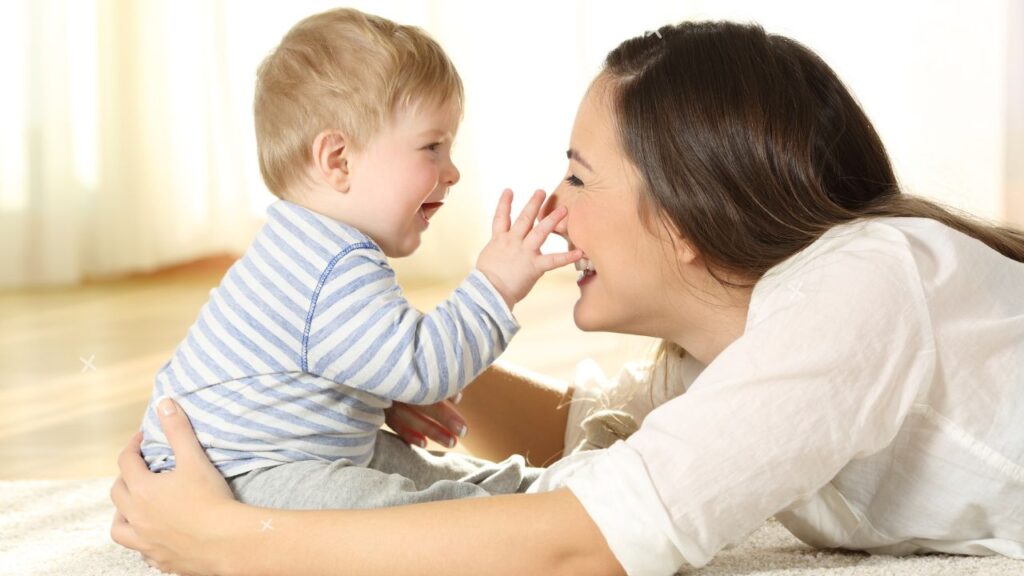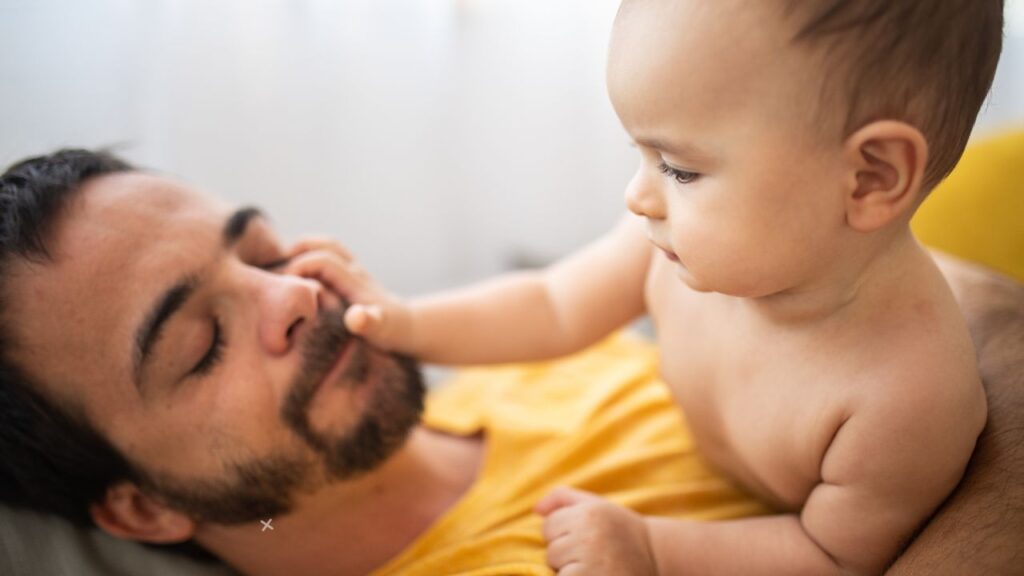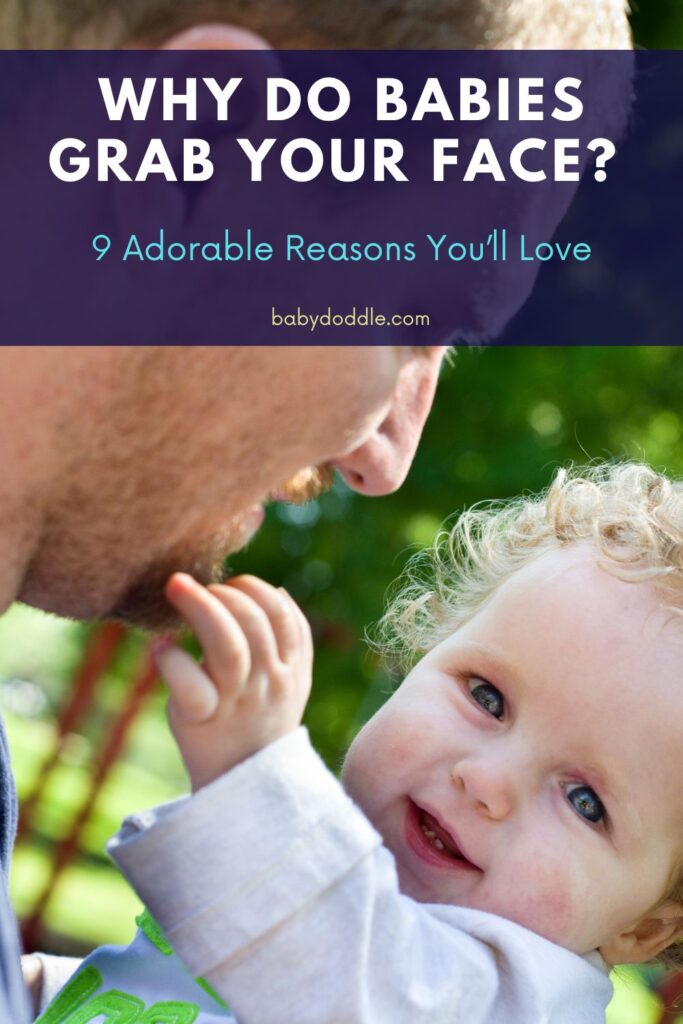As a new parent, few things make you melt more than when your sweet little bundle of joy reaches up to gently stroke, pat, pinch, or grab your face. Their tiny hands explore the terrain of your facial features with innocent curiosity, grabbing at your nose, eyes, ears, and mouth as if mapping out an undiscovered country.
When my daughter was first born, her instinct to grip my cheeks filled me with immense warmth and affection. Sure, her sharp little nails would sometimes scratch me, and occasionally she’d get a solid pinch on my nose or lip. But I didn’t mind at all—it was just her adorable way of getting to know me.
If you’ve ever asked yourself “why do babies grab your face so frequently?”, you’re not alone! All parents wonder about this behavior at some point. Understanding the key reasons behind this tendency can help you appreciate just how precious it really is. From sensory development to emotional bonding to instinctual needs, there are so many developmental, social, and biological factors at play driving babies to grasp onto faces.

The Science Behind Babies’ Obsession with Faces
Babies enter the world programmed to gaze at faces. Remarkably, infants less than 10 minutes old will stare longer at drawings of crude face-like patterns than any other shape. Scientists have discovered fascinating reasons behind this obsession.
Inside our brains are distinct neural pathways devoted solely to processing faces. Areas like the fusiform face area activate when we see facial configurations. Newborns’ brains already concentrate extra resources to making sense of these intricate stimulus. Learning to distinguish important faces becomes critical for survival.
Faces also provide vital social clues through microexpressions, gaze shifts, vocal echoes and beyond. Detecting the emotional states and intentions of caregivers helps ensure infants receive proper nurturing. No wonder their brains compel them to study faces so intently!
Additionally, extended face time promotes bonding through hormone release. Prolonged eye contact triggers surges of oxytocin, bringing relief and attachment. The mutual adoration between baby and parent lays neural foundations for lifelong relationship skills.
In the early months, babies move from innate face preference into recognizing familiar individuals. Around 2 months they start visually identifying parents’ faces. Then babies enter an analytical phase from 3 to 9 months as they systematically inspect every feature. This cognitive development parallels their emerging sense of separate selfhood.
Clearly faces facilitate far more than physical appearances alone. It’s no surprise babies grab onto them relentlessly to tap into these deeper social, emotional and neurobiological processes!
They’re Exploring Their New World
For newborns, touching everything within grasp is a crucial way to learn. Their sensitive little hands absorb tons of information about shapes, textures, temperature, weight, and flexibility. Faces make for especially exciting terrains with their combination of hard and soft bits like noses, lips, eyes, ears, and hair.
By grabbing your face, your little explorer gets to examine the feedback of firm bones contrasted with squishy cartilage and flexible skin. The varied landscape intrigues their developing minds and sensory perception. It’s like a playground full of unusual textures to interact with!
Next Steps:
Let your baby indulge their curiosity and need to grab your face often. Make lots of eye contact and happy facial expressions too so they associate faces with positivity.
They Recognize You
Around 2 months old when babies’ vision sharpens, they start visually recognizing faces, especially primary caregivers. Once your familiar visage enters their sightline, they’ll likely reach out to reaffirm that connection physically.
By grabbing your face, your baby is communicating “I know you! Yes, you’re my trusted person that makes me feel safe and loved.” It’s their instinctive way of celebrating this cognitive leap. They gain confidence realizing they have the power to summon you simply by touching.
Next Steps
React warmly when they grab your face, with big smiles, kisses, snuggles—whatever positive reinforcement helps them equate your face with good feelings. This builds secure attachment critical for development.
They’re Learning Cause & Effect
Babies are little scientists constantly experimenting to see how their actions influence the environment. When they grab a face and squeal happily at the reaction, it teaches them vital cause-and-effect principles.
They realize, “When I squeeze mommy’s cheeks, she gasps and tickles me. When I pat daddy’s scruffy beard, he laughs and bounces me.” These sensory experiments allow babies to gain some control over their world.
Next Steps
Ham it up! React strongly with silly faces, sounds and bounces when they touch you. That positive feedback motivates them to continue honing new skills.
They’re Testing Their Motor Skills
Developing the eye-hand coordination required to intentionally reach for and grasp objects is a major milestone. Around 3 months old, babies master grabbing things within their sightline. Faces make for ideal targets thanks to built-in visual focus on eyes, contrast, and movement.
As your baby’s dexterity improves, they’ll likely progress from open-palmed smacks to careful pokes, then eventually pincer grasps of fine details like nostrils and lips. Mastering these precise finger and wrist movements helps boost confidence.
Next Steps
Celebrate by cheering “Good grabbing!” when they succeed in touching your face. Over time, gently guide their hands away from sensitive spots like eyes. Offer teethers or toys with different textures too.

They Feel Connected to You
Research proves that loving touch is vital for growth. The skin hunger babies experience means regular face-to-face snuzzles release oxytocin, providing comfort and security. Your baby innately knows that physical closeness with you strengthens attachment.
By grabbing onto you—literally hanging onto your head and shoulders—they signal their trust and contentment. It’s like they’re proclaiming “You make me feel so safe and cared for!” These intimate moments of connection ensure healthy lifelong bonds.
Next Steps
Indulge their need for contact and affection, especially after separations. Cuddle up skin-to-skin. Let them playfully grab and pat your face frequently to continually reinforce your unbreakable connection.
They Love Attention
Around 5-6 months old, babies interact more socially. They quickly learn that grabbing faces elicits playful reactions—gasps, scrunched noses, silly sounds. What they’re really after is that priceless eye contact, those big smiles. They grab your face simply because they adore your attention.
It becomes a fun game where they excitedly grasp for your eyes or lips knowing it’ll make you chuckle and coo at them. They revel in that feeling of importance when your whole world narrows to delighting them. Smart little attention-seekers!
Next Steps
When they grab your face, shower them with affectionate words, kisses and smiles to satisfy their attention craving. Take turns making faces and laughing together. This builds their confidence and capacity for two-way communication.
They’re Communicating
Babies have an innate need to interact with others right from birth. Long before speech develops, they utilize touch to get their point across. Grabbing your face while looking intensely into your eyes is your baby saying: “I need you to focus on me now!”
They may be communicating excitement, frustration, fatigue or a host of other feelings. It’s their way of ensuring you recognize their current physical or emotional state. Decoding these early non-verbal cues is tricky but pays off in stronger connections.
Next Steps
Verbalize what you think they’re feeling when they grab your face and search your eyes urgently. “Oh I see you want mama to pick you up now. Okay sweetie, come here” shows you understand their cues. Respond to their signals promptly to validate their communication style.
Reading Your Baby’s Cues: What’s Your Little One Trying to Say?
As babies experiment with grabbing your face, their gestures reveal internal states too. Learning to decode the messages behind the maneuvers can help you meet their needs more intuitively.
- Light patting or stroking of your cheeks generally conveys contentment. They relax into tender caresses when soothed and secure.
- Persistent pulling down on your bottom lip likely indicates hunger. Babies recognize this gesture prompts feeding. Opening your mouth stimulates their reflex to latch.
- Forcefully squeezing eyes shut could signal fatigue. Babies sense eyes closing helps initiate sleep. By imitating, they request you transition them into soothing nighttime routines.
- Repeatedly finger and hand swiping suggests overstimulation. Limit eye contact and gentle cradling helps them cope.
- Gripping noses, ears or hair demonstrates a need for playful interaction. Respond with silly vocalizations and facial expressions to delight them!
Pay attention to patterns in their face hold cues. Consistently pair your responses to affirm understanding. Soon you’ll be able to anticipate their messages accurately: “Ah, sustained chin clutch means you want mama’s attention? Cuddle time it is!”
| Baby’s Gesture | What It Could Mean |
|---|---|
| Light patting of cheeks | Soothed/content |
| Pulling down lip | Wants feeding |
| Pressing on eyes | Ready for sleep |
| Grabbing chin | Seeking attention |
| Swiping hands | Overwhelmed |
They’re Curious About Features
Around 7-8 months, babies become infatuated with examining people’s faces up close. Their fine motor skills allow detailed exploration of eyes, eyebrows, noses and mouths. They’re intrigued by the similarities and differences between their own face and others’.
They discover that faces come in many shapes, colors and sizes. Yours might have crinkly eyes, dark freckles and a pointy chin totally unlike their smooth round cheeks. Mapping out these features helps them learn to recognize different individuals. It also lays early groundwork for self-awareness and empathy.
Next Steps
Point out and name features as they touch them. “Yes, these are Mommy’s big eyes! Here’s my little nose!” Add funny sound effects too like a horn honk when they squeeze your nose. Pull out family photos to connect names with faces. Their curiosity reveals an emerging selfhood.

It’s Instinctual
Experts confirm that babies under around 3 months old are hardwired through evolution to be drawn toward faces. Newborns can even imitate simple facial gestures! This instinct ensures that vulnerable infants bond with caregivers and receive nurturing attention.
When your baby grabs your face or orients toward you without you speaking, they’re actually responding to their innate programming. So in a sense, they gravitate toward faces because millions of years of evolution compel them to do so for survival! Pretty mind-blowing.
Next Steps
Take advantage of this built-in face focus by making frequent eye contact, smiling often and keeping your face close. The more positive face time, the better to cement caregiver bonds and nurture development. Their instinct drives vital emotional and social foundations.
Dealing with Hurtful Grabbing
Of course as much joy as it brings, many parents struggle with babies’ tendency to unthinkingly pinch, headbutt or claw their face too. When they get overstimulated or frustrated, your precious angel morphs into a grabby little gremlin! Thankfully there are effective ways to curb rough treatment.
The key is remaining calm and consistent. If they get too rough, gently say “no pinching” and remove their hands from your face. Distract with a teether toy or book allowing them an alternative outlet. Most importantly, reward them with cuddles and praise whenever they touch nicely.
Why Grab Faces While Nursing?
It’s common for breast- or bottle-feeding babies to simultaneously touch their mother’s face. This seems linked to the innate satisfaction of fulfilling physical needs. As hunger is soothed and calmness sets in, your warmth and closeness comforts them.
Experts suggest babies do this to help stay latched while nursing by anchoring themselves to your facial features. Or they may simply crave
the intimacy of stroking your cheek while nestled close feeding. It’s an indicator of their total relaxation, contentment, and trust with you.
Of course, sometimes those curious hands venture toward less comfortable areas like nostrils or mouths mid-meal. Gently guide them back to safer zones, and remain patient. Creating positive associations takes time.
With a nurturing approach, these moments of bonded bliss can actually help both mama and baby destress. Let some gentle face touching soothe you too as you sustain your little one.
Why Scratch Faces?
Between 4 and 8 months, scratching parents’ faces unfortunately becomes common too. Babies this age love investigating how their body moves and the impact of their movements. Swiping your face allows them to refine their motor skills and hand-eye coordination.
They may also use scratches to intentionally provoke reactions when bored, overwhelmed, teething or wanting attention. It’s a primal communication tool though one we find rude. With their undeveloped impulse controls, they simply don’t realize scratches hurt.
Use a calm, firm voice to say “No scratching” whenever it occurs. For frequent offenders, try clipping nails or having them wear mittens to dull the damage. Saying “Gentle touches” and modeling that can demonstrate ideal behavior. Eventually verbal and social cues will click.
Grabbing Faces While Falling Asleep
Many babies instinctively stroke or pat their caregiver’s face while drifting off too. The soothing motions combined with your familiar presence helps them relax into slumber.
Your steady breaths, facial warmth and comforting scent envelops them. Being able to literally hang onto you makes them feel secure enough to surrender consciousness. It’s their way of self-soothing combined with attaching.
Though sometimes inconvenient when you’re pinned under a napping baby, try appreciating these intimate moments. Use calming shushes, caresses and affirmations to ease their transition. Support this natural sleep association early on for better long-term rest.
In Conclusion…Treasure the Grabs!
When you understand all the psychological, developmental and primal motivators behind babies’ urge to grab faces, it’s impossible not to find it endearing. Recognize face-touching for what it often represents: curiosity about their expanding world, affection for their closest bonds, practice using new skills, and an innate need for security.
Will their exploratory squeezes sometimes get painfully overzealous? Absolutely. But with gentle guidance and consistency, they will learn. For now, try letting those tiny hands memorize the peaks and valleys of your features. Smother their fingertips with kisses as they discover. Mimic their wide-eyed wonder at each new facial revelation.
This innocent phase of discovery is fleeting. Before you know it, their grasp will dependably find gentler angles. Soak up the messy magic of it all. Let that insatiable curiosity about your face show you exactly how fascinating and important they find you. What could reveal love more purely than these little hands that cling with such fixated care to the edges of your being?
After all, there’s nowhere else in the whole world they’d rather be than cupping your cheeks, staring intently into your eyes, smiling as they realize…here is my home. Here is everything good. So lean closer and let them grab hold to their heart’s content!
FAQ – Why Do Babies Grab Your Face
Why do babies grab your face when nursing?
It’s common for breast- or bottle-feeding babies to stroke, grab, or pinch the caregiver’s face while eating. This seems to be their way of creating intimacy and bonding during feeding time. Touching your face helps keep babies latched while nursing as it anchors them close to you. The warmth and scent of your facial features is also soothing. It signals trust that they can relax into you. Some babies may explore nostrils or mouths out of simple curiosity too. Gently guide their hands to safer areas without scolding so they don’t associate feeding with negativity.
Is it normal for my baby to scratch my face a lot?
Frequent face scratching around 6-12 months old isdevelopmentally normal, though unpleasant! The key is responding calmly every time baby scratches to signal it’s unacceptable. Say “no scratching” and remove their hands from your face without anger. Distract them with a toy. Scratching can happen when overstimulated so give them space too. It also maybe an attention getting behavior or sign they’re teething. Try keeping nails trimmed short. If scratching remains problematic, say “Gentle touches” while modeling a soft face caress. It takes patience and repetition but they will learn more appropriate ways to explore.
My newborn keeps slapping himself in the face. Should I worry?
It’s very common in the early months for babies to accidentally hit themselves while their vision and motor skills develop. The good news is that newborns have natural protective reflexes that prevent face slapping from doing any harm. While startling to witness, rest assured your baby isn’t hurting themselves. You can try lightly holding arm and leg bands during swaddling to contain the jerky startles. Maintaining proper head support while holding them also minimizes uncontrolled arm flails. In most cases, babies outgrow the reflex reactions and willful face slapping by 3-4 months old.
How can I curb my baby’s attempts to poke my eyes?
As worrying as eye poking is, remember that it’s not malicious behavior. Your baby is simply exploring their newly discovered control of hands and causality. Consistently guide their hands away from your eyes whenever it occurs, redirecting to a safe teether toy whenever possible. Say “Gentle” if they try to return to poking eyes. Ensure you make eye contact and smile often during care routines so that they don’t associate your eyes only with negative scolding when redirecting their hands. Maintain a calm, patient approach and eventually the combination of maturity and guidance will end the eye jabs.
Why does my baby grip my face tightly when nursing or falling asleep?
Clutching a caregiver’s face while nursing or when drowsy is instinctual for many babies between 2-6 months old. Stroking features helps them regulate emotions, releases feel-good oxytocin, and anchors them to closely associate your presence with calmness. Tight face grasping can also facilitate maintaining a latch while breastfeeding. Some babies Innately develop a “loveys” type association between a tactile sensation like a blanket or their caregiver’s facial features and the ability to sleep. If tight face holding concerns you, experiment with alternative self-soothing aids for sleep like pacifiers. But rest assured it’s not a harmful behavior.












